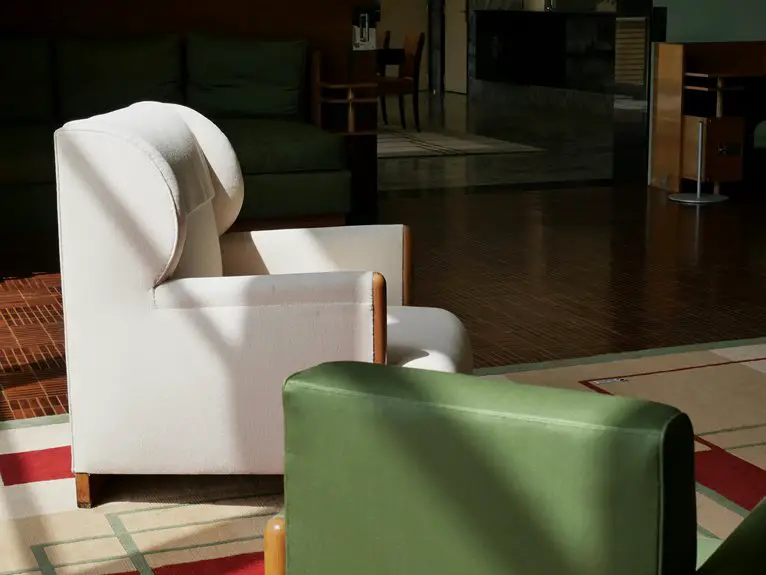If you’re considering jute fabric for your sofa or chair, you’ll appreciate its eco-friendly, breathable nature and unique rustic look that hides minor stains well. However, its coarse texture might feel rough, needing cushions for comfort. Jute is strong and ages gracefully but can fray or fade with heavy use and sunlight exposure. It’s best suited for low-traffic spaces and requires careful maintenance to keep it looking great. Let’s explore what else you should know before deciding.
Table of Contents
Key Takeaways
- Jute fabric offers an eco-friendly, biodegradable option with a rustic aesthetic for sofas and chairs.
- Its coarse texture provides durability and hides minor stains but may feel rough against the skin.
- Jute upholstery resists wear and maintains shape but can show fraying and fading with frequent use.
- It requires regular maintenance and is challenging to clean, especially from water stains or deep dirt.
- Best suited for low-traffic areas and pet-free homes due to its sensitivity to snags and rough texture.
What Is Jute Fabric?
Jute fabric is a natural fiber made from the jute plant’s stem. When you handle jute, you’ll notice its coarse texture and earthy color, which give it a rustic charm.
Jute fabric, derived from the plant’s stem, features a coarse texture and earthy tones that add rustic charm.
This fabric is created by spinning the long strands from the plant’s stem into yarn, then weaving them into cloth. You’ll find that jute is biodegradable and renewable, making it an eco-friendly choice.
It’s primarily grown in warm, humid regions, such as India and Bangladesh. While jute looks sturdy, it tends to be less flexible than other fabrics, so you might want to contemplate how it feels before using it extensively.
Understanding what jute fabric is helps you appreciate its natural origins and what makes it unique for furniture applications.
Advantages of Using Jute for Upholstery
When choosing fabric for your sofas and chairs, you’ll find that jute offers several standout benefits.
First, it’s an eco-friendly option since jute is a natural, biodegradable fiber grown with minimal pesticides. You’ll appreciate its breathable texture, which keeps your furniture cool and comfortable.
Jute also provides a unique, rustic aesthetic that adds warmth and character to any room. It’s lightweight, making it easier for you to handle and rearrange your furniture.
Plus, jute’s coarse texture helps hide minor stains and wear, so your upholstery looks good longer without constant upkeep.
Finally, jute is affordable compared to many other natural fabrics, allowing you to refresh your space without breaking the bank.
These advantages make jute a smart, stylish choice for upholstery.
Durability and Longevity of Jute Fabric
Although natural fibers can vary in strength, you’ll find that jute fabric stands up well to everyday use. Its robust fibers resist wear and tear, making it a practical choice for sofas and chairs that see frequent use.
When you choose jute, you’re opting for material that ages gracefully, often developing a unique patina over time. However, it’s important to protect it from excessive moisture, which can weaken the fibers.
Here’s what to expect from jute’s durability:
- Strong, coarse fibers that withstand abrasion
- Resistance to stretching and sagging
- Natural resilience against dirt and stains
- Tendency to hold shape without excessive wrinkling
- Slow fading when kept out of direct sunlight
This durability guarantees your furniture stays attractive for years.
Comfort and Texture Considerations
Beyond durability, comfort and texture play a big role in how you experience jute fabric on your sofas and chairs.
Jute has a naturally coarse texture, which might feel rough against your skin compared to softer fabrics like cotton or velvet. If you’re sensitive to texture, you may want to add cushions or throws to soften the seating area.
However, this coarseness gives jute a unique rustic charm and breathability, keeping your furniture cool and fresh. Over time, jute can soften slightly with use, improving comfort.
Jute’s coarse texture offers rustic charm and breathability, softening with time for added comfort.
Keep in mind that jute isn’t stretchy, so it holds its shape well but won’t offer much give. Considering these factors will help you decide if jute’s texture aligns with your comfort preferences.
Environmental Impact and Sustainability
You’ll appreciate that jute fabric is biodegradable, breaking down naturally without harming the environment.
Since it’s made from a renewable resource, using jute helps reduce reliance on synthetic materials.
Plus, eco-friendly production methods keep its environmental footprint low, making it a smart choice for sustainable furniture.
Biodegradability Benefits
Biodegradability plays an essential role in reducing the environmental footprint of your furniture choices.
Choosing jute fabric means you’re opting for material that naturally breaks down without leaving harmful residues. When your sofa or chair reaches the end of its life, jute decomposes quickly, unlike synthetic fabrics that linger in landfills for decades.
This process minimizes pollution and supports healthier soil.
Imagine your old jute cushion:
- Returning nutrients to the earth
- Avoiding toxic chemicals
- Reducing landfill mass
- Supporting microbial life
- Leaving no lasting waste
Renewable Resource Usage
While choosing furniture materials, consider how renewable resources impact the environment and sustainability.
Jute fabric comes from the jute plant, a fast-growing crop that requires minimal pesticides and fertilizers. When you opt for jute, you support a material that replenishes quickly, reducing strain on ecosystems.
Unlike synthetic fabrics derived from fossil fuels, jute’s renewable nature means it won’t deplete nonrenewable resources. Additionally, jute cultivation helps maintain soil health and prevents erosion, which benefits the environment further.
By selecting jute for your sofas and chairs, you contribute to a cycle of responsible resource use.
However, remember that renewability alone doesn’t guarantee sustainability—it’s just one part of a larger environmental picture you should keep in mind when making your choice.
Eco-Friendly Production Methods
Because jute fabric production relies on traditional, low-impact techniques, it offers a more eco-friendly alternative to synthetic materials. When you choose jute for your sofas and chairs, you support processes that minimize harm to the environment.
The fiber is harvested by hand, avoiding heavy machinery. Water use stays low since retting—separating fibers—happens naturally in ponds or rivers. No harmful chemicals bleach or dye the fabric, keeping pollutants out of the ecosystem. Plus, jute plants absorb a lot of CO2, helping combat climate change.
Think about:
- Gentle hand-harvesting in rural fields
- Natural retting in clean water bodies
- Sun-drying fibers under open skies
- Minimal chemical use during processing
- Biodegradable waste returning to soil
Maintenance and Cleaning Tips for Jute Upholstery
If you want your jute upholstery to stay looking fresh and last longer, regular care is crucial.
Start by vacuuming your jute furniture weekly using a brush attachment to remove dust and debris gently. Avoid soaking jute with water, as it’s highly absorbent and prone to mold. Instead, use a slightly damp cloth to spot clean any stains immediately.
For tougher stains, a mild soap solution works well, but test it on a hidden area first to verify it doesn’t damage the fibers. Keep your jute pieces away from direct sunlight to prevent fading and brittleness.
Rotate cushions regularly to guarantee even wear. By following these simple steps, you’ll maintain the natural beauty and durability of your jute upholstery for years to come.
Potential Drawbacks and Limitations of Jute Fabric
While jute fabric looks great, you might find it less durable than other upholstery materials, especially with heavy use.
Its coarse texture can also feel rough against your skin, which may affect comfort.
Let’s explore these limitations to see if jute suits your needs.
Durability Concerns
Though jute fabric offers a natural and eco-friendly option for sofas and chairs, you should be aware of its durability limitations. Jute tends to wear out faster than synthetic fabrics, especially in high-traffic areas. It’s prone to fraying and can weaken when exposed to moisture, making it less ideal for homes with pets or children.
You might notice fading if the fabric is in direct sunlight for extended periods. Additionally, jute can be rough, which sometimes leads to snagging or pilling. Consider these points before choosing jute:
- Visible wear along armrests and seat edges
- Frayed threads after frequent use
- Water spots or stains that are hard to remove
- Color fading under sunlight exposure
- Snags from sharp objects or pet claws
Keep these durability concerns in mind to guarantee jute suits your lifestyle.
Comfort and Texture
Because jute fabric has a coarse texture, you might find it less comfortable for long periods of sitting compared to softer materials.
Its roughness can feel scratchy against your skin, especially if you prefer a smooth, plush surface. Unlike cotton or velvet, jute lacks natural elasticity, so it doesn’t offer much cushioning or give. If you’re sensitive to texture, this might be a drawback that makes your seating experience less enjoyable.
Additionally, jute doesn’t breathe as well as some fabrics, which can cause discomfort in warmer climates. While layering cushions or throws can help, it adds extra maintenance.
Frequently Asked Questions
Can Jute Fabric Be Dyed in Vibrant Colors?
You can dye jute fabric in vibrant colors, but it absorbs dye unevenly due to its coarse texture. You’ll need to use fabric-specific dyes and techniques to achieve bright, lasting hues on jute successfully.
Is Jute Fabric Hypoallergenic for Sensitive Skin?
Like a gentle whisper, jute fabric tends to be hypoallergenic, so you won’t usually face irritation if you have sensitive skin. However, its coarse texture might still cause discomfort, so always test before committing.
How Does Jute Compare Cost-Wise to Other Upholstery Fabrics?
You’ll find jute fabric generally costs less than leather and many synthetic options. It’s affordable and eco-friendly, but sometimes pricier than basic cotton. So, your budget and style preferences really shape your choice.
Can Jute Fabric Be Used Outdoors on Patio Furniture?
You wouldn’t believe it, but jute fabric isn’t built to withstand outdoor elements like a superhero! You shouldn’t use it on patio furniture since moisture and sun can quickly damage its natural fibers, causing wear and fading.
Does Jute Fabric Emit Any Odors When New?
You might notice a mild, natural earthy smell when you first get jute fabric. It usually fades quickly once it’s aired out, so don’t worry—it’s not a harsh chemical odor and won’t linger long.
- How to Get Crisp, Clean Lines in Your Tie-Dye - July 13, 2025
- Pumpkin Face Tie-Dye: Folding and Dyeing Instructions - July 13, 2025
- Advanced Shibori Techniques for Textile Artists - July 13, 2025





